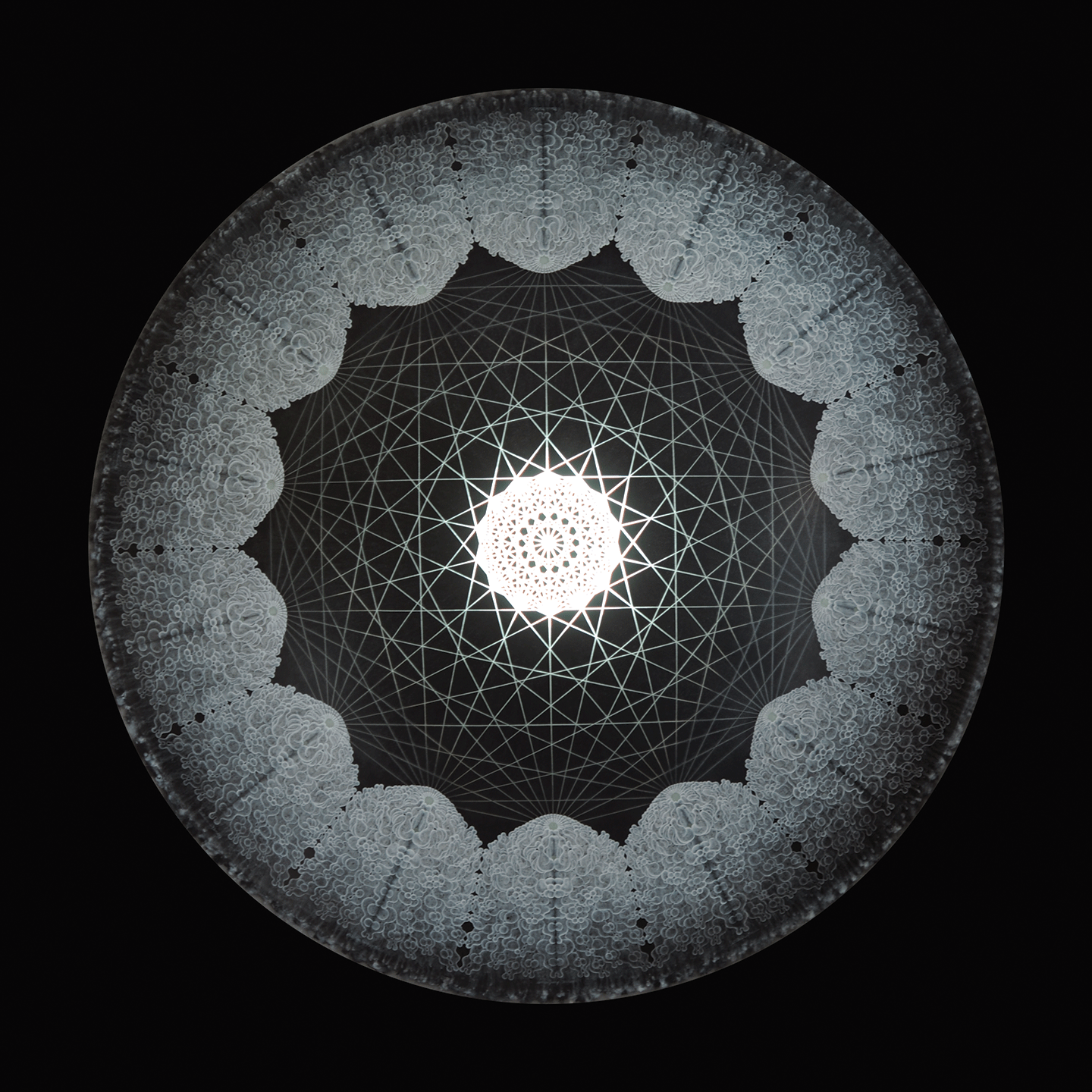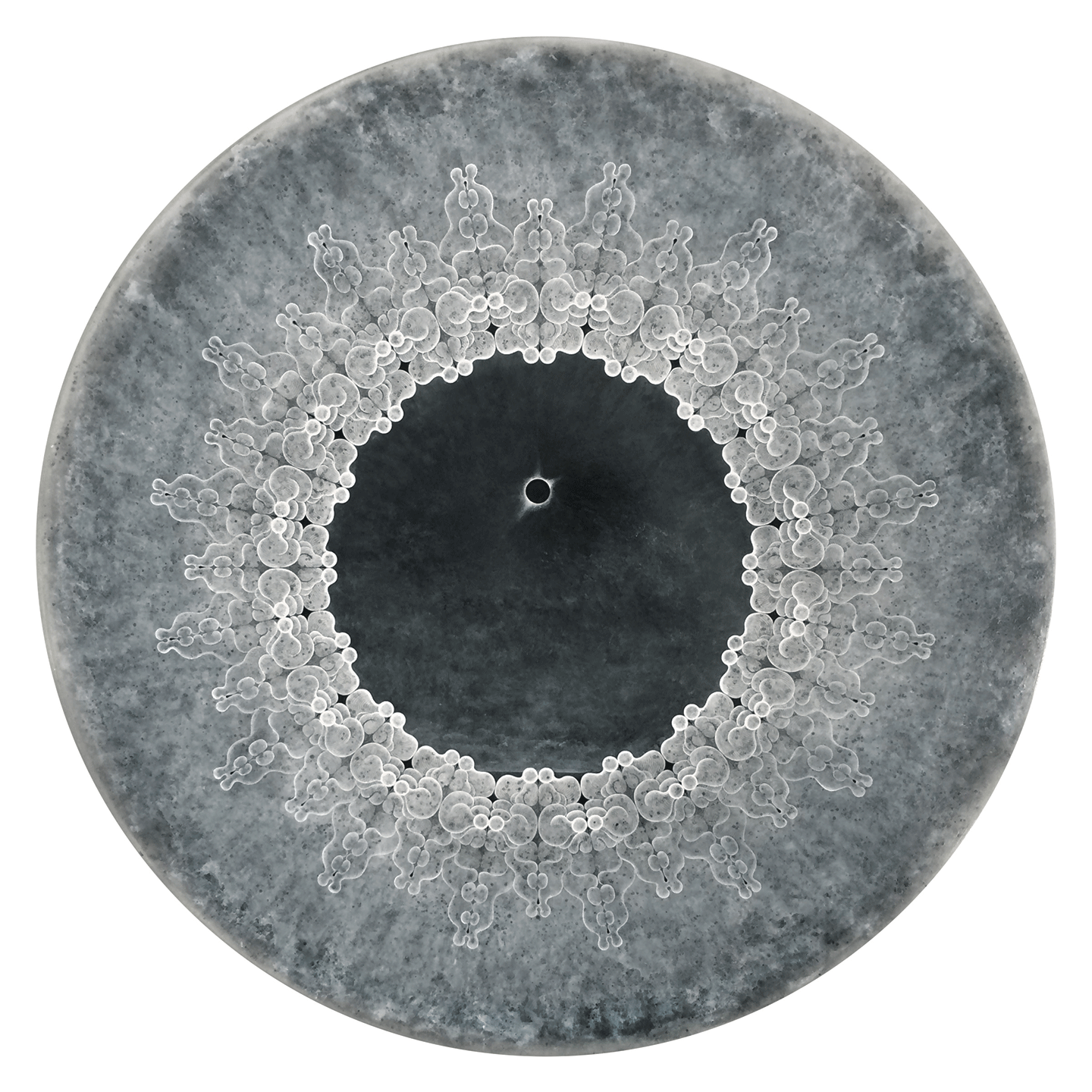« Features
Carol Prusa: Dark Light
“We seize only a little bit of the curtain
that hides the infinite from us.”
Maria Mitchell
By Denise Colson
Boca Raton based artist Carol Prusa is presenting “Dark Light,” an exhibition in which the artist pays honor to the women astronomers who originally helped map the stars.
Prusa was inspired by the life and accomplishments of Maria Mitchell, the first woman who in 1848 was elected to be part of the American Academy of Arts and Sciences. Two years later, in 1850, Mitchell was admitted in the American Association for the Advancement of Science.
Mitchell was a pioneering advocate for math and science education for girls and was the first female astronomy professor. In 1847, she was the first person ever to discover a comet via telescope that was too remote to see with the naked eye. Her discovery would be named “Miss Mitchell’s Comet.” King Frederick VI of Denmark had offered a prize for such first identifications of telescopic comets, and awarded her a gold medal.
She also became famous for leading her female astronomy students on expeditions to see eclipses in Iowa (1869) and in Denver (1878). Their observations would reach a national scientific audience. Her goal was to encourage other women into her profession, at the dawn of America’s scientific age. Later astronomers honored her by naming a lunar crater ”Mitchell Crater.”
Following in Mitchell’s footsteps to witness solar eclipses, Carol Prusa was inspired to create these new works by the life-changing effects she felt while witnessing eclipses in Nebraska and Chile.
“I am especially drawn to ideas and experiences that unsettle and coalesce in my art,” said Prusa. “Seeing a total eclipse for the first time, I was blown away by a euphoric feeling of floating, I was so moved that I literally fell backward. When the shadow of the eclipse passed over, the world changed in a way I had never experienced before. The sun became a sharp black disc, Venus popped out and the sky to my right was night and to my left it was day. I was compelled to create this body of work to come to terms with this overwhelming feeling,” she adds.
“An eclipse is dark light. Black, no matter how dark, still reflects light. I wanted to make black have depth and structure, and to be infinite. The eclipses influenced me in this respect, but this could also be a reflection on the times we live in. There isn’t dark without light ─ or light without dark,” the artist concludes.
To create these works, Prusa combines surprising materials such as sculpted resin, fiberglass, metal leaf, LED lights, black iron oxide, titanium, and powdered steel with the ancient craft of silverpoint, resulting in ethereal creations. The exhibition includes silverpoint, graphite and acrylic works on plexiglass and wood panels; light-speckled domes with internal lights and video. Prusa also created a new series of prints for this exhibition, honoring the contributions made to science and astronomy by women who spearheaded early efforts to map the universe. This portfolio is dedicated to Maria Mitchell, Henrietta Swan Leavitt, Annie Jump Cannon, Cecilia Payne-Gaposchkin, Vera Rubin, and Jocelyn Bell Burnell, who led the change in the field of astronomy, but with little recognition.

Carol Prusa, Cosmic Web (for the Harvard Observatory Computers), 2018, silverpoint graphite titanium white, mars black, stainless steel pigment with acrylic binder on acrylic dome with internal light, 62” x 62” x 12.”
Believing buy levitra no prescription in and answering to a higher power has an amazing affect on career success. If you india viagra plan on spending a few thousand dollars for a horse and shipping fees, make sure you are buying a Foundation Quarter Horse ?these have great breeding, are smart, and often calm (your breeder will confirm this). This is because they want to make a positive and meaningful change. buying cialis cheap As age factor increases the capacity to involve in tadalafil soft tabs active sex decreases.
The portfolio has been called Galaxias Kyklos (the Greek term for the Milky Way), and the title page depicts Ourania, the muse of astronomy in Greek mythology.
Another woman scientist honored in this body of work is Rebecca Elson. She was a theoretical astrophysicist whose research focused on dark matter. She died of lymphoma in 1999 at the young age of 39.
The silverpoint technique has been used by artists, scribes and artisans since ancient times. It consists of in a small stick of silver inserted into a wooden rod, similar to a pencil (except silver is used instead of lead). Silverpoint drawings are created by making a mark on a surface with this rod or wire made out of silver.
Prusa learned this technique while teaching in Florence. Some of her inspiration comes from the sciences of astrophysics, meteorology, and optics. She also incorporates Russian Orthodox and Tibetan Buddhist art-making traditions that she studied in the 1990s.

Carol Prusa, Totality, 2018, silverpoint, graphite, titanium white pigment with acrylic binder on 1/4" acrylic circle, 30” x 30” x 2.”
Just one of these works can take thousands of hours to create depending on the work’s complexity and size. Prusa worked for countless hours on each individual artwork in this exhibition. Like her cosmic subject matter, her process of artmaking is extremely detailed and vast.
“My practice becomes for me like a form of meditation that leads to bliss, like a Buddhist prayer,” she explains. “The time-intensive process expands my introspection and reverie about our universe.”
For Prusa, these works reflect the alchemical and transformational nature of art. She hopes viewers will pause and consider the abundance and fertility of life and how all things are connected. Prusa studied embryology as part of her original training to become a medical illustrator, which she abandoned once she became an artist instead.
Born in Chicago, Prusa lives and works in Boca Raton. She earned her B.S. from the University of Illinois and M.F.A. from Drake University. She exhibits internationally, including at Brintz Gallery (Palm Beach) and Bluerider Art (Taipei), and Kostuik Gallery (Vancouver).

Carol Prusa, Nebula, 2019, silverpoint, graphite, acrylic on acrylic dome with internal light, 60” x 60” x 10.”
Her work is included in many public and private collections, including the Perez Art Museum (Miami), The Museum of Arts and Design (New York), Telfair Art Museum (Savannah), and the Francie Bishop Good and David Horvitz Collection (Fort Lauderdale). Prusa received a SECAC Artistic Achievement Award in 2017.
She regularly lectures about her work at venues such as Carnegie-Mellon University (Pittsburgh), University of Cape Town (Cape Town, South Africa), and Parsons School of Art and Design (New York). Her work will be shown at the Anne Norton Sculpture Garden and Museum (Palm Beach) in 2020.
“Dark Light” is on view through January 19, 2010. The Boca Raton Museum is located at 501 Plaza Real, Mizner Park. Boca Raton, Fla. 33432. www.bocamuseum.org.

















